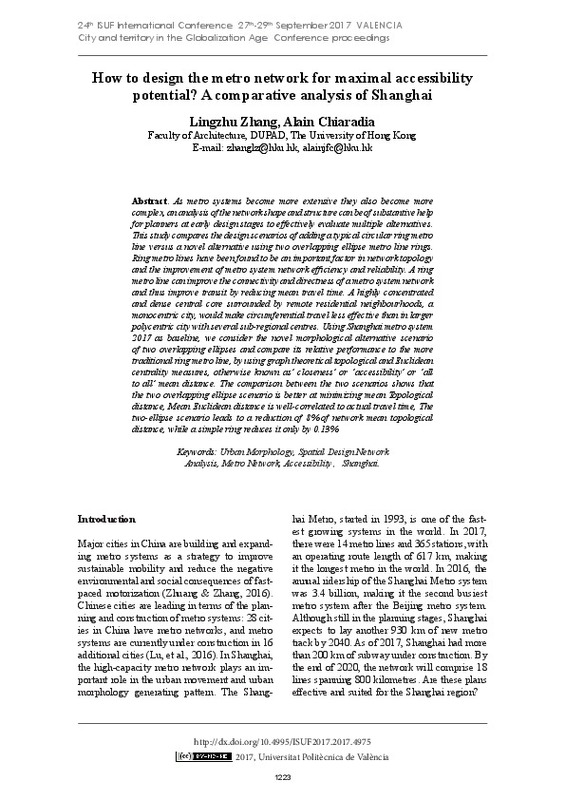JavaScript is disabled for your browser. Some features of this site may not work without it.
Buscar en RiuNet
Listar
Mi cuenta
Estadísticas
Ayuda RiuNet
Admin. UPV
How to design the metro network for maximal accessibility potential? A comparative analysis of Shanghai
Mostrar el registro sencillo del ítem
Ficheros en el ítem
| dc.contributor.author | Zhang, Lingzhu
|
es_ES |
| dc.contributor.author | Chiaradia, Alain
|
es_ES |
| dc.coverage.spatial | east=121.47370209999997; north=31.2303904; name=Xina, Shanghai Shi | es_ES |
| dc.date.accessioned | 2018-12-03T07:38:42Z | |
| dc.date.available | 2018-12-03T07:38:42Z | |
| dc.date.issued | 2018-04-20 | |
| dc.identifier.isbn | 9788490485743 | |
| dc.identifier.uri | http://hdl.handle.net/10251/113405 | |
| dc.description.abstract | [EN] As metro systems become more extensive they also become more complex, an analysis of the network shape and structure can be of substantive help for planners at early design stages to effectively evaluate multiple alternatives. This study compares the design scenarios of adding a typical circular ring metro line versus a novel alternative using two overlapping ellipse metro line rings. Ring metro lines have been found to be an important factor in network topology and the improvement of metro system network efficiency and reliability. A ring metro line can improve the connectivity and directness of a metro system network and thus improve transit by reducing mean travel time. A highly concentrated and dense central core surrounded by remote residential neighbourhoods, a monocentric city, would make circumferential travel less effective than in larger polycentric city with several sub-regional centres. Using Shanghai metro system 2017 as baseline, we consider the novel morphological alternative scenario of two overlapping ellipses and compare its relative performance to the more traditional ring metro line, by using graph theoretical topological and Euclidean centrality measures, otherwise known as’ closeness’ or ‘accessibility’ or ‘all to all’ mean distance. The comparison between the two scenarios shows that the two overlapping ellipse scenario is better at minimizing mean Topological distance, Mean Euclidean distance is well-correlated to actual travel time, The two-ellipse scenario leads to a reduction of 8% of network mean topological distance, while a simple ring reduces it only by 0.13%. | es_ES |
| dc.format.extent | 9 | es_ES |
| dc.language | Inglés | es_ES |
| dc.publisher | Editorial Universitat Politècnica de València | es_ES |
| dc.relation.ispartof | 24th ISUF International Conference. Book of Papers | es_ES |
| dc.rights | Reconocimiento - No comercial - Sin obra derivada (by-nc-nd) | es_ES |
| dc.subject | Urban morphology | es_ES |
| dc.subject | Spatial Design Network Analysis | es_ES |
| dc.subject | Metro Network | es_ES |
| dc.subject | Accessibility | es_ES |
| dc.subject | Shangai | es_ES |
| dc.title | How to design the metro network for maximal accessibility potential? A comparative analysis of Shanghai | es_ES |
| dc.type | Capítulo de libro | es_ES |
| dc.type | Comunicación en congreso | es_ES |
| dc.identifier.doi | 10.4995/ISUF2017.2017.4975 | |
| dc.rights.accessRights | Abierto | es_ES |
| dc.description.bibliographicCitation | Zhang, L.; Chiaradia, A. (2018). How to design the metro network for maximal accessibility potential? A comparative analysis of Shanghai. En 24th ISUF International Conference. Book of Papers. Editorial Universitat Politècnica de València. 1223-1231. https://doi.org/10.4995/ISUF2017.2017.4975 | es_ES |
| dc.description.accrualMethod | OCS | es_ES |
| dc.relation.conferencename | 24th ISUF 2017 - City and Territory in the Globalization Age | es_ES |
| dc.relation.conferencedate | Septiembre 27-29,2017 | es_ES |
| dc.relation.conferenceplace | Valencia, Spain | es_ES |
| dc.relation.publisherversion | http://ocs.editorial.upv.es/index.php/ISUF/ISUF2017/paper/view/4975 | es_ES |
| dc.description.upvformatpinicio | 1223 | es_ES |
| dc.description.upvformatpfin | 1231 | es_ES |
| dc.type.version | info:eu-repo/semantics/publishedVersion | es_ES |
| dc.relation.pasarela | OCS\4975 | es_ES |








